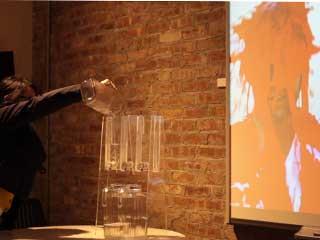Jason Rosen
Jee Won Kim
Luca Shapiro
Matt Richardson
Phan (Pan) Visutyothapibal
Zena Koo
digidrench
digidrench is an interactive video installation in which playback is controlled by rising and falling water levels.
http://www.digidrench.com

Classes
Introduction to Physical Computing
Introduction to Physical Computing
digidrench is an interactive video installation in which the user controls video playback by filling and draining three tanks. As the water level rises, the video plays forward; as it lowers, the video reverses. The user gets to interact with the very same materials that are used on screen. As the user pours, liquid falls on screen. There is a direct correlation between the user's action and the video content, allowing for more playful and meaningful engagement with the project. We are very proud to be showing digidrench at Gizmodo Gallery 2011 at White Box on Friday, December 9th.
Background
We wanted to capitalize on each collaborator's unique strengths during digidrench's assembly. The production involved five distinct phases: idea generation, tank fabrication, video production, arduino and max programming, and presentation development. Each of us took the lead at various points in the process and took the time to share our individual expertise with the rest of the group. We researched existing water-based sculpture and tried to find an original take on the liquid media controller.
Audience
Everyone.
User Scenario
Three tanks sit on a table above three pitchers. A screen hangs beside them. The user is invited to pour water from the pitchers into the tanks and watch with surprise as liquid begins spilling onscreen and drenching the digital victims. When the user drains the tanks, the video plays in reverse.
Implementation
The acrylic tanks and glass pitchers fit on a small tabletop and require a computer running Max connected to a medium to large display. The computer is hidden out of view, perhaps under the table. The display can be a projector, computer monitor, or television.
Conclusion
In the process of making digidrench, we took time to brainstorm and fully develop our idea before executing it. We set firm deadlines for ourselves to commit to a theme, a concept, and a design. This structured schedule allowed us plenty of time to fabricate the project, which was time-consuming and filled with trial and error. We all worked together so that no one part of the process rested on one person's shoulders. This project was proof positive that collaboration is a challenging, but ultimately incredibly rewarding experience.
Background
We wanted to capitalize on each collaborator's unique strengths during digidrench's assembly. The production involved five distinct phases: idea generation, tank fabrication, video production, arduino and max programming, and presentation development. Each of us took the lead at various points in the process and took the time to share our individual expertise with the rest of the group. We researched existing water-based sculpture and tried to find an original take on the liquid media controller.
Audience
Everyone.
User Scenario
Three tanks sit on a table above three pitchers. A screen hangs beside them. The user is invited to pour water from the pitchers into the tanks and watch with surprise as liquid begins spilling onscreen and drenching the digital victims. When the user drains the tanks, the video plays in reverse.
Implementation
The acrylic tanks and glass pitchers fit on a small tabletop and require a computer running Max connected to a medium to large display. The computer is hidden out of view, perhaps under the table. The display can be a projector, computer monitor, or television.
Conclusion
In the process of making digidrench, we took time to brainstorm and fully develop our idea before executing it. We set firm deadlines for ourselves to commit to a theme, a concept, and a design. This structured schedule allowed us plenty of time to fabricate the project, which was time-consuming and filled with trial and error. We all worked together so that no one part of the process rested on one person's shoulders. This project was proof positive that collaboration is a challenging, but ultimately incredibly rewarding experience.

